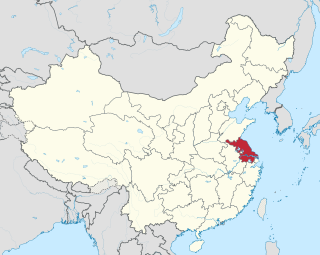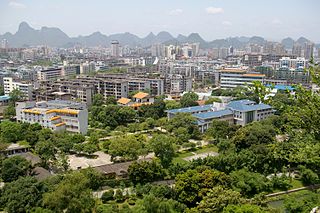
Guilin, formerly romanized as Kweilin, is a prefecture-level city in the northeast of China's Guangxi Zhuang Autonomous Region. It is situated on the west bank of the Li River and borders Hunan to the north. Its name means "Forest of Sweet Osmanthus", owing to the large number of fragrant sweet osmanthus trees located in the region. The city has long been renowned for its scenery of karst topography and is one of China's most popular tourist destinations.

The Qilian Mountains, together with the Altyn-Tagh also known as Nan Shan, as it is to the south of Hexi Corridor, is a northern outlier of the Kunlun Mountains, forming the border between Qinghai and the Gansu provinces of northern China.

Fan Zhongyan from Wu County of Suzhou, courtesy name Xiwen (希文), ratified as the Duke of Wenzheng (文正公) posthumously, and conferred as Duke of Chu (楚國公) posthumously, is one of the most prominent figures in the Chinese history, as a founder of Neo-Confucianism and a great statesman, philosopher, writer, educator, military strategist, and philanthropist. Fan was one of the most prominent figures of the Song dynasty, an era when China possessed the world’s largest economy and population. After serving the central government for several decades, Fan rose to a seat of Chancellor over the entire Chinese empire nearing the zenith of its pre-modern economic, social, and cultural development. Fan's philosophical, educational and political legacy is one that changed the course of the Chinese history, one so powerful that it continues to exert a profound impact on the Chinese civilization today, and his philosophy and writings remain a core component of the Chinese literary canon. While Fan spent the majority of his time governing China, his myriad deeds and teachings, well represented by his well-known saying "Be the first to bear the world's hardship, and the last to enjoy its comfort" (先天下之憂而憂,後天下之樂而樂), have served as an inspiration to the Chinese people for a thousand years. Fan is one of the most prominent members of the Fan family and is considered a Saint in China by some, other Saints including the philosophers Confucius and Mencius.
Kao Ping-tse was a Chinese astronomer. He was entirely self-taught in this field. The crater Kao on the Moon is named in his honor.
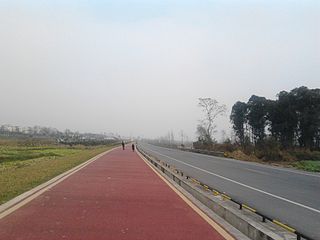
Pengzhou, formerly Peng County or Pengxian, is a county-level city under the jurisdiction of Chengdu, the capital of Sichuan province, People's Republic of China, some 19 km (12 mi) northwest of Chengdu. There is an expressway that connects Pengzhou to Chengdu. It is bordered by the prefecture-level divisions of Deyang to the northeast and the Ngawa Tibetan and Qiang Autonomous Prefecture to the north.
Fan is the transliteration of several Chinese family names, of which the most common are 范 and 樊.

Mount Yari is one of the 100 Famous Japanese Mountains. The 3,180-metre-high (10,433 ft) peak lies in the southern part of the Hida Mountains of Japan, on the border of Ōmachi and Matsumoto in Nagano Prefecture and Takayama in Gifu Prefecture. The priest Banryū (1786–1840) founded a temple there.
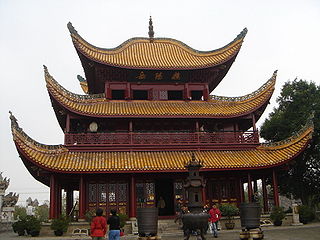
Yueyang Tower is an ancient Chinese tower in Yueyang, Hunan Province, on the shore of Lake Dongting. Alongside the Pavilion of Prince Teng and Yellow Crane Tower, it is one of the Three Great Towers of Jiangnan. Yueyang Tower became famous for Memorial to Yueyang Tower (《岳阳楼记》) written by Fan Zhongyan, an eminent minister of the Northern Song dynasty (960–1127) in China.
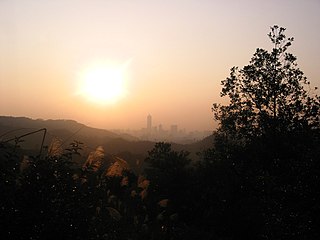
Baiyun Mountain, also known as White Cloud Mountain, is a mountain located a few miles to the north of Guangzhou, China, and which is at a height of 427m.

Tiāntóng Rújìng was a Caodong Buddhist monk living in Qìngdé Temple on Tiāntóng Mountain in Yinzhou District, Ningbo. He taught and gave dharma transmission to Sōtō Zen founder Dōgen as well as early Sōtō monk Jakuen.

Tiandeng is a county in the southwest of Guangxi, China. It is the northernmost county-level division of the prefecture-level city of Chongzuo.

Hongshan District forms part of the urban core of and is one of 13 districts of Wuhan, the capital of Hubei province, People's Republic of China. The district is named for Mount Hong, located near East Lake. It is the most populous of all the districts, and is the most spacious but least densely populated among the city's seven core districts.

Taiji Cave is a karst cave located on Shilong Mountain (石龙山) in Guangde County, Xuancheng City, Anhui Province, People's Republic of China, where the provinces of Jiangsu, Zhejiang and Anhui meet. Ming Dynasty writer and poet Feng Menglong described the cave as one of the "Four Absolutes Under Heaven". It is also considered a primary "Place of Enlightenment" by Taoists, similar to the Bodhimanda of Buddhism. The 200-million-year-old cave is divided into dry and wet layers representing the yin and yang of Chinese philosophy.
In February 2004, the Chinese State Council included the cave on its fifth list of National Scenic Attractions. It is also a 4A rated National Tourism Area.
Tiãntángzhài is the second highest peak of the Dabie Mountains located on the border between Hubei and Anhui provinces in the People's Republic of China. Straddling Hubei's Luotian County and Huanggang City along with Jinzhai County in Anhui, the mountain rises to a height of 1,729.13 metres (5,673.0 ft) above sea level. It forms the watershed between the Huai and Yangtze Rivers and is also known as the "Number one pass in the southeastern Yangtze River region" (吴楚东南第一关).
Tianping rolling stock depot is the rolling stock depot of Line 1, Suzhou Rail Transit. It is located in Tianping Village, Mudu Town, Wuzhong District, Suzhou. The depot opens to public occasionally.

Qingshanqiao is a town in Ningxiang City, Hunan Province, China. It borders Loudi in the west, Lianyuan in the northwest, Longtian Town and Shatian Township in the north, Liushahe Town in the east, and Xiangxiang in the south. As of the 2010 census it had a population of 52,000 and an area of 138 square kilometres (53 sq mi). It is located at the intersection of Highway S209 and Highway S311, on the banks of the Chu River.

Baishi Town is an urban town in Xiangtan County, Xiangtan City, Hunan Province, People's Republic of China. As of the 2000 census it had a population of 37,900 and an area of 98 square kilometres (38 sq mi).

Wushi Town is an urban town in Xiangtan County, Xiangtan City, Hunan Province, People's Republic of China. It's surrounded by Xiangxiang City Town on the west, Paitou Township on the north, Jinshi Township on the east, and Shitan Town on the south. As of the 2000 census it had a population of 37,583 and an area of 96.12 square kilometres (37.11 sq mi).

Yamawaro or yamawarawa (山童) is a yōkai that appears in mountains that is told about in Western Japan, starting in Kyushu. Sometimes it is said that they are kappa who have come to dwell in the mountains. In the Ashikita District, Kumamoto Prefecture, in addition to "yamawaro," it is also called "yamawarō", "yamamon", "yamanto", "yaman wakkashi", and "yaman ojiyan". Also, in the Kuma District of the same prefecture, they can also be called "yaman-tarō" (山ん太郎) or "yamanbo" (山ん坊).



